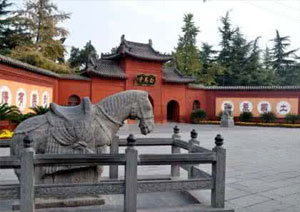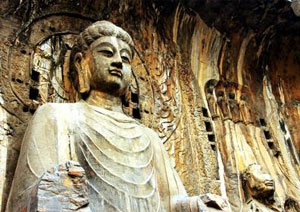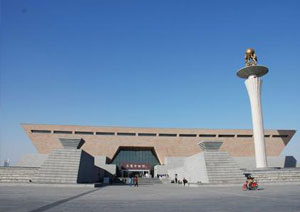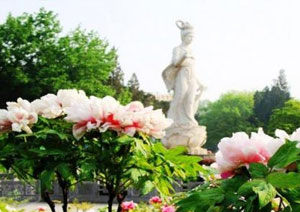
 The Baima Temple (Baima Si) is one of (if not the), oldest Buddhist Temple in China. From the outside, the Baima Temple looks as if it houses the common collection of ornaments, decorated with cartoon style colors and images that are so prevalent in many of China's cities. However, this is in fact one of the most impressive and truly holy temples in the entire province.
The Baima Temple (Baima Si) is one of (if not the), oldest Buddhist Temple in China. From the outside, the Baima Temple looks as if it houses the common collection of ornaments, decorated with cartoon style colors and images that are so prevalent in many of China's cities. However, this is in fact one of the most impressive and truly holy temples in the entire province.
Located 12km east to the ancient capital city of Luoyang, facing the Luo River in the south and sitting back to the Mang Hill in the north, is the White Horse Temple, and also named Baima Temple. Established by the Han Dynasty in 68 AD when Buddhism started to spread, this temple is believe to be the first Buddhist temple built by the government in China.
 The world-famous Longmen Grottoes are located 12km south of Luoyang, where Xiang Hill and Longmen Hill stand facing each other. Yi River washes its wav northward through the gorge. Taken a distant view, Longmen Grottoes just like a pair of Chinese gate towers. So during the Zhou and Qin dynasties, it was called "Yi Que" (Gate of Yi River). Later, when the Sui established its capital city in Luoyang, the palace gate was just facing Yi Que, hence the name "Longmen" which means "Dragon Gate". These caves are considered one of the three great sculptural treasure troves in China. The other two are the Mògao caves in Dunhuáng (Gansu Province), and the Yúngang Grottoes in Dàtóng (Shanxi Province), the precursor to Lóngmén.) In general, the limestone is harder at Lóngmén than at Yúngang, and the caves closer to the river, making it easier to discern the details but more difficult to see the caves as a whole. In the year 2000, Longmen Grottoes was listed by UNESCO as a World Cultural Heritage Site.
The world-famous Longmen Grottoes are located 12km south of Luoyang, where Xiang Hill and Longmen Hill stand facing each other. Yi River washes its wav northward through the gorge. Taken a distant view, Longmen Grottoes just like a pair of Chinese gate towers. So during the Zhou and Qin dynasties, it was called "Yi Que" (Gate of Yi River). Later, when the Sui established its capital city in Luoyang, the palace gate was just facing Yi Que, hence the name "Longmen" which means "Dragon Gate". These caves are considered one of the three great sculptural treasure troves in China. The other two are the Mògao caves in Dunhuáng (Gansu Province), and the Yúngang Grottoes in Dàtóng (Shanxi Province), the precursor to Lóngmén.) In general, the limestone is harder at Lóngmén than at Yúngang, and the caves closer to the river, making it easier to discern the details but more difficult to see the caves as a whole. In the year 2000, Longmen Grottoes was listed by UNESCO as a World Cultural Heritage Site.
 Luoyang Museum is in the center and busiest section of China's ancient capital of Luoyang City. It is located at the north side of Mid Zhongzhou Road, built in 1985. The whole area covers more than 200,000 square meters. The main building is imposing, dignified, and seems like one imitating an ancient era.
Luoyang Museum is in the center and busiest section of China's ancient capital of Luoyang City. It is located at the north side of Mid Zhongzhou Road, built in 1985. The whole area covers more than 200,000 square meters. The main building is imposing, dignified, and seems like one imitating an ancient era.
It is the only integrated historic museum in Luoyang City. It has an impressive collection of nearly four hundred thousand (400,000) pieces of local, historic, rare and cultural relics from the past dynasties. Besides being numerous and in various kinds, they are of high quality collection. Among them are the bronze wares, the pottery-made tomb figures, and the Tang Three Color, considered to be special and famous worldwide.
 Wangcheng Park Covering an area of 67 hectares is the largest public park in Luoyang, and is well worth a visit. Of all the times to come, it is best here during the spring, especially in April when the Peony is in blossom. The Jian River flows through the park. There is a small zoo, but the park's natural scenery is more of an attraction. An archaeological reconstruction inside the park is also of interest; there is an Ancient Cultural Section that is made up of a complex of mock ancient buildings in the Zhou Dynasty (1,100-221 BC) style. The garden itself was built on the original site of the ancient Zhou city. The most exciting part of the park, however, is the peony beds that are everywhere.
Wangcheng Park Covering an area of 67 hectares is the largest public park in Luoyang, and is well worth a visit. Of all the times to come, it is best here during the spring, especially in April when the Peony is in blossom. The Jian River flows through the park. There is a small zoo, but the park's natural scenery is more of an attraction. An archaeological reconstruction inside the park is also of interest; there is an Ancient Cultural Section that is made up of a complex of mock ancient buildings in the Zhou Dynasty (1,100-221 BC) style. The garden itself was built on the original site of the ancient Zhou city. The most exciting part of the park, however, is the peony beds that are everywhere.

